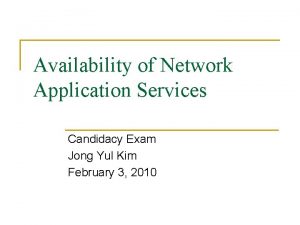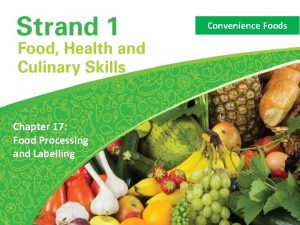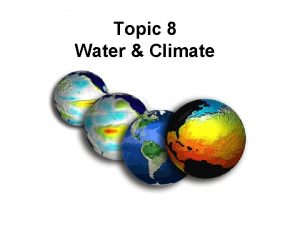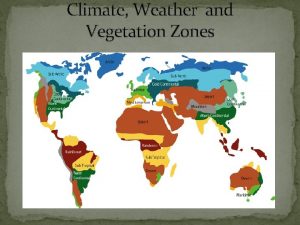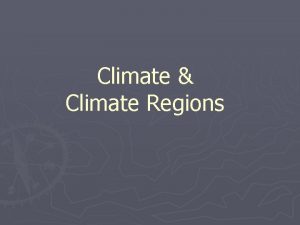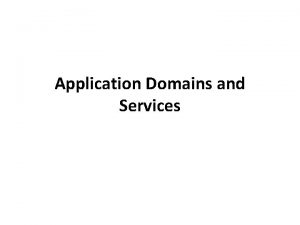Examples of Climate Services and their Application in























- Slides: 23

Examples of Climate Services and their Application in Priority Sectors Agriculture and Food Security Ramasamy Selvaraju Climate, Energy and Tenure Division, FAO, Rome Regional workshop on climate services at the national level for the Caribbean Port of Spain, Trinidad and Tobago, 29 -31 May 2013

Proportion of Agricultural Population in the Caribbean Region

Water Use in Agriculture Sector

Agricultural Exports/Imports in the Caribbean Region

Food Security Situation in the Caribbean Region

Smallholder farmers and fishers are in the front line of climate impacts

Current Gaps in climate services and interfacing mechanisms in agriculture and food security sector • Demand for climate information is diverse: – localized, timely and easily understandable – diverse cropping systems and decision cycles – Suitable for user needs –Institutions, Ag. service providers, irrigation managers, input suppliers, market intermediaries, local cooperatives, microfinancing, farmers, fisherman, livestock herders • Supply is often constrained by insufficient data and resolution – information is general and understanding of data and technical terms • customization for farm level application, planning, trade, food emergencies and extension services are not well developed – communication – inequitable access, inadequate content, format, accuracy and timeliness of operational forecasts – poor response to forecasts due to resource constraints and lack of information on appropriate management alternatives – Agricultural extension services have diverse responsibilities

Challenge is to meet needs of all. . . Ø Ministries of Agriculture, Forestry, Livestock and Fisheries Ø Ministry of Water Resources, Irrigation Authority, Irrigation Commission Ø Departments of Agriculture, Livestock, Forestry and Fisheries Ø Agriculture, forestry and fishery support services (extension) at all levels Ø Reservoir operators, Water managers, Water Users Associations Ø Private Sectors (Insurance companies, traders, marketing) Ø Smallholder farmers and groups Ø Livestock herders and associations Ø Fishermen and their associations Ø Forest dwellers, Forest user groups Ø Ag. Cooperatives Ø Micro-finance operators Ø Farm laborers

Knowledge sharing mechanisms at the local level Ø Farmers knowledge sharing mechanisms relevant to local context is the key for effective communication of value added climate information • Farmer field schools integrating climate and weather information • Farmer participatory climate workshops • Local climate information centers

Sustaining knowledge sharing mechanisms at the local level • • Support establishment of risk management laboratories managed by local authorities that interface between the information users and providers. Meteorological stations established at community level in coordination with the National Meteorology and Hydrology Service (Eg. SENAMHI) in order to provide localised information to livestock and crop farmers. NMHS provide training to the promoters, responsible for data collection and communication of climate information to members. The communal authorities negotiated with the local authority (council) to set a budget line for the operation and maintenance of risk management laboratories.

Farmers social capital – local institutions can plan a key role Ø Social cohesion (e. g. community networks, local institutions, norms and relationships) is critical for managing climate risks • Providing credible information to farmers as a group can motivate pro-active decision making • Local networks shape the farmers social interactions leading to better participatory decisions

Livelihood analysis, vulnerability and risk mapping • Provide advance information about the livelihood baseline and their vulnerability to climate phenomenon. • Too many details. . . too little to offer

Enhanced role of NMHS at decentralized levels • • National climate services at decentralized levels are primarily involved in recording data and communicating it to the national centers and back to the users Increased engagement of the local staff with intermediaries (e. g Agricultural extension personnel, water managers, disaster managers) can play an important role between developers of climate information and users in different sectors. Promoting volunteers, local observers (part time) to enhance interaction with users User community especially advisory services (agriculture, water, risk reduction and health) that provide specific value added products need local partner from NMHS

Prioritizing the need for climate information services in sectoral policies, programmes and investment plans • Promote inter-agency working groups and national committees (align with existing mechanisms) • Set realistic targets (considering Government commitment and external funding) • A strategic framework and implementation plan with indicative budget estimate can help to advance implementation

Strengthening Institutional and Technical capacities q National Meteorological and Hydrological Services (NMHS) Ø understanding the needs of agriculture support services and farmers Ø development of customized climate information products and services q Agricultural Support services and Community Based Organizations (CBOs) Ø development of contingency plans incorporating new technologies Ø improving impact data collection, monitoring and analysis Ø developing impact outlooks and management alternatives considering local needs Ø communication of information and receiving feedback

Crop monitoring and yield forecasting Ø Analysis of meteorological, climatic and crop data • provision of near real-time information about the crop state, in quality and quantity • possibility of early warning on expected production Ø Planning for timely interventions by the Government – contingency plans – alternate livelihood strategies – response plans for food aid Sub-national Maize yield forecast

Enhanced collaboration to improve methods, tools and value added information Water stress Maps FAO Rainfall Estimates 10 -DAY TOTAL RAINFALL (mm) - 3 rd dekad September 2011

Clim. Africa - Climate change predictions in Sub-Saharan Africa: impacts and adaptation Medium Term (5 – 10 years) Warning Systems (MTWS) • The MTWS is intended to fill the gap between seasonal – scale assessments and long-term impact projections • Identify the future Areas of Concerns (AOCs) and likely hotspots of vulnerabilities and sensitivities Coping with a changing climate: Considerations for Adaptation and Mitigation in Agriculture (FAO, 2009)

Agriculture and Food Security Exemplar • Provide a global governance function for managing climate risks to agriculture and food security • Define the needs of agriculture and food security users for climate information • Provide technical support and feedback for agriculture and food security sector functions, including research, capacity development, communication and operations • Communicate and advocate to promote the effective use of climate information within agriculture policy, research and practices

Needs identified. . • Capacity development of agriculture professionals and communities to better assess, manage and monitor agriculture risks of climate variability and change • capacity development of agriculture professionals and communities to access, understand use climate information and products appropriately • Improved, standardized, and quality controlled agriculture data, which is compatible with environmental and climate information • Monitoring and evaluation of the appropriate, effective, and cost effective use of climate information for agriculture decisions • Research and forecasting of agricultural impacts associated with climate variability and climate change in collaboration with the climate research community • Development of Agriculture Early Warning Systems (AEWS) and other interface tools • Sustainable financial and technical support • Better collaboration with the climate community for interdisciplinary policy, practice and research

Break-out Groups 1. Review the needs for climate services in your sector at the national and local levels; 2. Identify the major areas of improvement needed to foster closer interactions between climate service providers and users; 3. Discuss and recommend appropriate mechanisms for improving interactions with users; 4. Propose ways to improve communication between climate service providers and users; …Cont’d

Break-out Groups 5. Identify the structure and process steps to be undertaken in the implementation of the UIP; 6. Identify, describe and propose 3 -4 case studies that could be undertaken to show the benefits of an integrated approach to the UIP, linking existing mechanisms and if necessary developing linkage mechanisms at the national and local levels; 7. Provide details on how we build capacity to implement the User Interface Platform at national and local levels.

Thank you
 Climate change 2014 mitigation of climate change
Climate change 2014 mitigation of climate change Factors affecting climate
Factors affecting climate Android application framework components
Android application framework components Romeo and juliet prologue translated to modern english
Romeo and juliet prologue translated to modern english Cisco waas vs riverbed 2017
Cisco waas vs riverbed 2017 Network application services
Network application services Integrated services vs differentiated services
Integrated services vs differentiated services Wake county human services community services center
Wake county human services community services center Formulating and clarifying the research topic
Formulating and clarifying the research topic Define convenience foods.
Define convenience foods. Lever body
Lever body Quantified statement and negation examples
Quantified statement and negation examples Actions and their consequences examples
Actions and their consequences examples In on at
In on at Cause and effect examples
Cause and effect examples Smallest vegetation region in canada
Smallest vegetation region in canada Percolation vs infiltration
Percolation vs infiltration Vegetation of north america
Vegetation of north america Scandinavian climate and geography
Scandinavian climate and geography How does wind affect weather and climate
How does wind affect weather and climate Weather climate and society
Weather climate and society How do prevailing winds affect climate
How do prevailing winds affect climate Which colonial region contained rocky soil and cold climate
Which colonial region contained rocky soil and cold climate Climate and vegetation zones
Climate and vegetation zones





